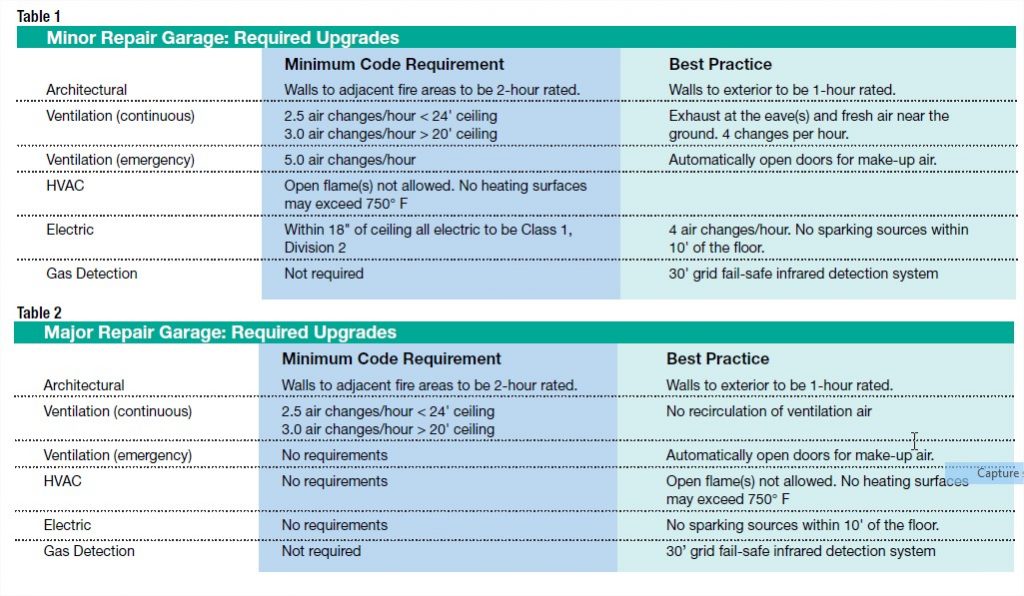Retrofitting existing facilities to accommodate next generation vehicles.
By Evan Williams
Over the past few years, many hauling operations have considered switching their fleets to CNG or have already begun or completed the transition. The switch from diesel fuel to CNG can be linked to a myriad of reasons including reduced operating and maintenance costs, easier cold starting, increased reliability, municipality requirement, etc. An important consideration in the evaluation of making a switch to CNG should be regarding the steps necessary to modify an existing maintenance facility to allow these vehicles to be serviced in a code-compliant, safe manner.
Code Analysis/Required Modifications
The first steps in evaluating if converting to CNG would be right for your company would be to perform a code analysis of the facility. This analysis will need to be based on what type of services the facility will perform. There are typically three tiers of facilities that codes address:
Vehicle storage areas (indoor parking).
Minor Repair Facilities, which includes service activities that do not impact the fuel system or generate heat in excess of 750° F (welding, grinding, etc.); excludes brake repair, tire work and nighttime activities.
Major Repair Facilities, which includes areas where there will be welding, vehicle bodywork or engine overhauls.
An architect or engineer should be brought on to perform a detailed code check and establish code requirements that the building will need to address. Codes vary by State and jurisdiction, but the most common are:
- International Building Code (check for State/Local amendments)
- International Mechanical Code (check for State/Local amendments)
- International Fire Code (check for State/Local amendments)
- National Electric Code
- NFPA 30A – Motor Fuel Dispensing Facilities and Repair Garages
The type of facility and codes should help create a list of code-minimum required building improvements. Tables 1 and 2 lay out the minimum code requirements and best practices for each of them. (Note: these tables are subject to state/local code amendments, as well as future changes to codes.)
Implementation
Once the facility modification plan has been determined (based on a detailed code analysis), the next step should be to get buy-in from the facility operations staff. The operations staff will need to live with the facility, and obtaining their input at this stage is important. The code may dictate performance metrics for several systems, but the system design is up to the design team. For example, the HVAC requirements may specify systems with no surface in excess of 750° F. This can be achieved through special radiant tube heaters, GFA units with “100 percent make-up air” located outside the building, or in-floor radiant heat. While all can be code compliant, often the staff prefer in-floor radiant, as it creates a much more comfortable working environment. The next steps of the implementation involve working with the facility staff to create a work plan that allows the facility to remain operational while upgrades are being performed. Ideally, this would include converting one or two bays at a time, and rotating through the facility until all the bays are upgraded.
Training and Procedures
Even after the physical improvements to the facility are completed and emergency systems have been tested and are operational, the system is still not complete. A critical part of the upgrade involves developing Standard Operational Procedures (SOP) and training to ensure the maintenance staff understands how to work in a safe manner. The SOP should have clear procedures regarding staff training/frequency, major and minor infractions, responsibility matrix, best practices and emergency actions to be taken in the event of gas release. The SOP development should include fuel/gas safety consultants and also involve the staff that will be operating under it. This will help ensure that the SOP is practical and can be implemented on a day-to-day basis. Defining these requirements in a vacuum can lead to policies that may be well intentioned, but impractical and rarely followed. Smart SOP guidelines will enhance the levels of compliance and employee buy-in. Just as investments in the building to accommodate CNG will lead to a safe and productive work environment, investments in employee training and development of workplace policies/procedures will also contribute to facility safety and productivity.
Realizing the Final Product
Converting a maintenance facility to accommodate a CNG fleet is not a simple task. From complex and overlapping code requirements that vary by jurisdiction, to existing facilities that may not be ideal candidates for retrofitting, and investments in staff training and procedures, there are many considerations that need to be addressed. Working with a team that has a familiarity with these requirements and the needs of the waste industry can help sort out the must-haves from the nice-to-haves and realize a final product that is practical, code-compliant, safe and cost-effective.
Evan Williams is a Design Manager for Cambridge Companies (Griffith, IN), a design-build firm working with the waste industry for more than 20 years. During this time, more than 100 solid waste design-build projects have been completed including new build, repairs, upgrades and/or modifications at transfer stations, recycling centers/MRFs, hauling companies, landfill facilities, office buildings and more. Cambridge continually monitors the industry to determine any new needs, changes or improvements that will benefit their clients and improve their design-build solutions. Evan can be reached at (219) 972-1155, via e-mail at [email protected] or visit www.CambridgeCoInc.com.

